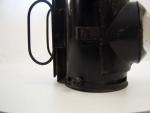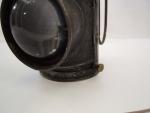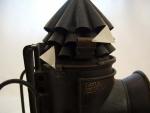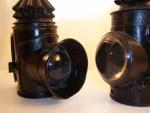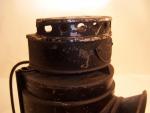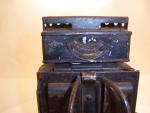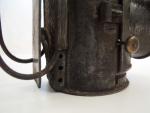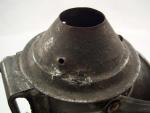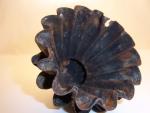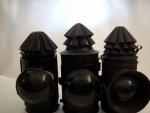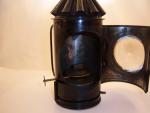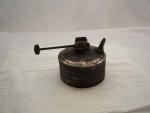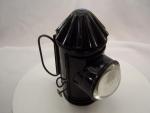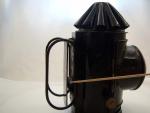-
Posts
6,486 -
Joined
-
Last visited
-
Days Won
10
Content Type
Profiles
Forums
Blogs
Gallery
Events
Store
Everything posted by Brian Wolfe
-
The next advancement in operating the blackout feature was to provide an external adjustment knob. While the principal of an internal cylinder with a light emitting hole cut out of it remains the method of turning this internal cylinder was improved. A handle in the form of a simple steel pin, a flat piece of metal with a rolled curl or a turned brass knob was installed at the base of the lantern. A slot that ran across the bottom of the lamp, about ½ of the way around allowed the officer to turn the internal cylinder more easily. I’ve never seen one of these mounted at the top of the internal cylinder and can only guess they don’t exist because I would think they would be prone to binding during operation. That’s only speculation on my part and if any of the members have any further information on this, or any point, I would welcome it. Two examples of the external handle, or knob, are shown below.
-
Today’s flashlights can be turned on and off in ...well... a flash, thanks to battery power. We’ll get into the age of battery power a bit later. The early lamps had to be ignited whether they were candle or oil burning and extinguishing a flame so that the police officer was not giving away his position and then re-igniting the flame when required was not a practical option. I have no examples of lanterns that do not have a black out feature so I can’t say they ever existed. However the lanterns I do have go back to the candle burning era, which I am confident, in the case of my specimens, would be early Victorian and even perhaps a bit older. All have manually operated black out features. In the case of the example shown to the left below there is a cylinder with a circular opening cut out of it. This cylinder fits into the main body cylinder and the burner rests on the bottom of the lamp separate of the blackout device. In order to block out the light one would turn this cylinder by grasping the vent, or chimney, and either block out the light or turn it the other way to once again have a light beam. This, of course, supports the theory that the additional cone allowed a cooler surface to prevent burns to the officer’s hand. You can imagine how hot a single cone would become very quickly. The specimen to the right below was made by Hiatt and while having the basic same method of blacking out the light has taken a further step in adding an adjustment “handle”, indicated by the arrow. In addition this particular specimen also as a small guide that keeps the inner cylinder from being removed. While this may have worked well in the past I find that it tends to bind when you are operating the handle in an attempt to block out the light, or re-establish it.
-
There has been mention of the “protecting rim for the lens” and I thought I would show an example here. I have read that this may also have been an attempt to direct the light forward by preventing it from spreading out from the sides of the bulls-eye lens in all directions. These lens protectors came in different patterns but the one shown is fairly basic in design and they all serve the same purpose.
-
Because my interest in German medals is pre WWII I like the look of a bar without the TR medals, however, I agree that it shows that the recipient served his country once again after his WWI service. I know some collectors here who think that the British WWII Defence Medal worn with the WWI Trio somehow looks wrong and I'll admit that I do like the trio on their own. Regards Brian
-
Hi Monty, I try to do as many repairs as possible though many specimens (even beyond lanterns) in the collection are left as is. I've repaired broken medal hangers, leather scabbards and a few of the lamps. I'm fortunate to have held several profession in my life time, including cabinet making and stained glass work and since I still maintain my shop I can "play" witrh such repairs. Regards Brian
-
Hello Ayedeeyew, That is some fasinating information and I am thinking that it would make a great project for the New Year. Your first image shows the ARP lamp and I was very interested to see one of these in actual use. I have one in the collection but never seen one in use. Thank you very much, it's just like getting a Christmas present to my way of thinking . Regards Brian
-
Hello Ayedeeyew, Thank you for your contribution to this thread. Your observations are most enlightening (bad pun). I suppose there would be enough air movement between the conmbustion chamber and the outer body of the lamp to keep it from over heating. That makes complete sense as otherwise the lamp itself would get too hot for use. Your observations on the additon of and extra cone or two also makes a lot of sense and I thank you for that observation. With such input this post is becoming a valuable research tool. I have more examples of the features you mention which I will post later. I agree with your suggestion that as time went on the improvements were made. I have a candle burning lantern with an external switch for the black out feature so it may be more of an individual manufacturer's design or a cost control as to how, if at all, the light was hidden. I would not be concerned that your lantern has been repainted as many collectors do not see this as a detriment, on occasion I've done it myself. In one case the seller, or someone else, removed all of the original finish and left it as bare metal, of course I repainted it to resemble the original. Thanks again for your post. Regards Brian
-
Before we move on from the chimney topic I would like to show a different idea in the configuration of a chimney. This lantern was designed by a policeman with the needs of a constable in mind, as he saw it. I will feature the lamp on its own later but I wanted to show the interesting chimney on his design. The lamp itself has several design changes, I would classify as improvements, over the standard lantern of the day, therefore I will give it special attention later on in this series.
-
We spoke of the cone on the chimney and showed the top of the combustion chamber where the smoke and combusted air escapes. Of course it would serve no purpose if all we had was a chimney and no way for fresh air to enter the chamber, remember our combustion requirements tri-angle. Most of the specimens in the collection provide for entry of fresh air into the chamber. I would have to think that the lamp’s construction, mainly around the door and the light shield (we’ll look at that later on) would provide sufficient draft to provide the flame with oxygen laden air, however, at least in the specimen pictured below this much needed fresh air is supplied via vent holes situated at the back and bottom of the lantern.
-
In the collection I have one specimen that requires some repair to the chimney cone and I thought that this was a good time to use it to show the parts usually covered and therefore go unseen. In the one photo you can see the exterior of the combustion chamber come with the hole at its apex as mentioned in the last post. Over this venting hole is affixed the smoke dispersal cone or cones. In the case shown there are two cones, one above the other. This cone would normally be riveted onto the body of the lantern. You can see that the lower, or bottom, cone has a hole that corresponds with the one in the top of the combustion chamber. With the addition of extra cones the smoke would be further dissipated upon exit from the lantern. I do not believe the flow of air into the chamber would be increased as the exit hole in the chamber itself is unchanged and the addition of extra cone would not increase or ease the exit of combusted air significantly.
-
The Lantern Chimney This time of the year – three days before Christmas – it is most appropriate to be speaking of the chimney, in our case the police lantern’s chimney. One of the basics taught in Fire School is the “Fire Requirements Tri-angle”. To have fire you need three things, air, fuel and heat. Eliminate any one of the three and you no longer have the requirements for fire. This simple equation applies to any situation, including the lantern if a flame is desirable. The lantern requires air to enter the combustion chamber and therefore also needs a chimney to facilitate the movement of combusted air out of the chamber so that fresh air may be drawn in to satisfy the needs of tri-angle model noted above. It holds true that basically the larger the opening the better the flow of air, or draft; to a point of course. The top of the combustion chamber of a typical lantern is conical with an opening at its apex. In order to dissipate the resulting smoke a cone is placed over the opening in the combustion chamber. There may be as many as three of these cones forming the top of the lantern. Examples of the three different configurations of cone placement are shown below.
-
I seldom say that this or that is the best on the market but in this case I know what I am, talking about. The best reference in the world on bayonets is the now out of print, "Bayonets of the World" a four volume set by Paul Kiesling. It was published by MIlitary Collectors Service, back in 1976. There are highly detailed technical drawings of every basyonet from the days of the plug bayonet to the latest issued weapon (up to 1976). Technical drawings are far superior to photographs in my opinion. With each drawing comes all the statistics you would ever want. I would suggest that you look at the offerings of the book dealers at your local gun show as these do come up for sale, one at a time usually. Honestly, this set makes all other references compost. If you pourchase a bayonet and THEN want an identification be sure to post it on the forum and I'll be glad to research it for you, as will the other members of course. Regards Brian
-
Nick, What great possibilities for the issuance of the Golden Kite, considering both the Rosso-Japanese and the later WW I medals are present. A very interesting group. Regards Brian
-
Azyeoman: I'll take a group of medals that were worn by the recipient over mint specimens any day. Your medal collection is top notch in my opinion, well done. I hope there is more to come and if so please let us see them. Nick: My eyes are not good enough to see close detail on the Golden Kite. Do you think this is an early issue, maybe Meiji or Tashio period? It looks early to me but I can't be sure from my computer screen. Regards Brian
-
Hello Azyeoman, Thank you for posting photos of your collection it is most interesting indeed. I too would like to see close up photos of your collection. Regards Brian
-
Hello Mervyn, I believe it is too obsecure a topic to garner much resopnse, however, once completed I hope it will be a good reference for any members, present and future, who might buy one of these interesting items. There is a period detective show on Canadian television set in Victorian Toronto. The show is called Murdoc Mysteries. The lead actor was shown, in one episode, holding a lit bulls eye lantern, not by the handles, but with his hand wraped around the sides. I would think the real lantern would be too hot to have done this and they probably used a battery powered light in place of the burner for the program. This shows how little people know about such items from our past. My next series of photos, in a day or so, will deal with the chimneys of the oil burners. Regards Brian
-
Police Lanterns I thought we’d spend some time looking at the different features of the typical British Police Lantern. Most of these features were carried through to the early battery powered flashlights, or torches, in one form or another demonstrating just how effective they were. One of the first things to notice is the glass lens which is convex at the front and flat on the interior side. This magnifies the light considerably and was especially important when the early candle-lit versions were used. I will look at these and other lanterns later on. The term “bulls-eye lamp” came from the appearance of this lens. While I am not showing this next feature in this series of photos there is a sliding metal “screen” that can be used to close off the light without having to extinguish the flame. At the back of the light chamber is a round piece of polished metal used to intensify the light produced and reflecting all of the light possible through the bulls-eye magnifying lens. I think this shows up in the photo, if not then you will see this feature in other examples as we move along. On this particular lantern you can see the latch that holds the front door, containing the lens, shut. Usually this is a simple strip of metal that snaps over a metal protrusion on the side of the lamp. This one actually slides up and down thereby locking the door closed. The adjustment wheel for the lamp can also be seen where the door meets the body of the lantern. Not all burners had external adjustments, some were simply a burner without a way to adjust the flame and some had the adjustment device on the inside of the lantern. Much depended on the manufacturer’s design. On the top of the lantern can be seen the vent cap or chimney. These came in single, as in this version, double and even triple cones to produce a taller chimney. Again, I’ll show these later. On the back are some features that all police lanterns share. The double “D” handles that fold to the sides to allow the belt hook to be employed and, of course, the belt hook itself. This model has a metal bump, indicated by the pointer in the photo to keep the lantern from working its way upward and therefore eventually off the officer’s belt. Anyone who has ever clipped a large carpenter’s tape measure to their belt knows how easily these can work up and off the belt. Ah, for a dollar every time I have had to climb back down the ladder to retrieve that tape measure. In the last photo you can see a typical oil burner. This is not the one in the lamp featured but it is similar. The first oil burners were unboundedly whale oil but later on they used coal oil also called kerosene. NEVER, as I read on one forum, did they use gasoline (petrol) in these burners. I trust this was a simple slip of the memory or an accidental substitution of the word gasoline for coal oil. Using gasoline in one of these burners would make Molotov proud, as you have just produced an incendiary device. Keep tuned for more on British Police Lanterns Regards Brian
-
The iconic lantern We see so many things in our world that are considered as iconic. Staying with the theme of this post; when people all over the world think of the British Bobby what do their mind’s eye envision? They probably think of a police helmet (sometimes called a custodian helmet), perhaps the famous cylindrical whistle and maybe even a truncheon, or night stick. I doubt police lantern comes to mind, yet during my research into the historical background for this post the opposite seems to be the case, at least in the past. Comical post cards, advertisements for all kinds of products and honour roll documents abound with depictions of the police officer holding his trusty lantern. As we progress through this post I will show such examples of what I am talking about. Mervyn has covered the history of lanterns very well in the opening post so I will try not to repeat it. Like Mervyn I am only going to deal with British lantern and later early flashlights. The common features that differ between police and civilian lanterns and later the early flashlights is that the lanterns often have a convex lens, thereby coining the term “bulls eye lamp”. In addition to this they have a double handle at on the back along with a wide hook to fasten it onto the officer’s belt. Some lamps have a second hook-like feature to keep the lamp from working its way up and off the belt. Another feature is a device to shut the light off without requiring the lamp to be extinguished. I will show some example as we go along. On the older lamps one of the features that stands out, to my eye at least, is a cone- shaped chimney. These can be single or stacked one on the other up to three high. These chimneys are common to all fuel burning lanterns and not just police issue. I’m not sure that Mervyn covered this point earlier but in his book, “The Policeman’s Lot” it tells of policemen holding the lit lantern under their cloaks, or capes, in order to stay warm on cold damp winter nights. Many times, Mervyn writes, the officer would return to the station at the end of his shift with his face blackened by soot produced by the burning fuel in the lamp. A note regarding Mervyn’s book, if you don’t have one, get one. The information is invaluable. Contact Mervyn for details. Now to move past that shameless plug for Mervyn’s book; I will post an early candle burning lantern that would have been used just after the one Mervyn sent me photos of and I botched them by getting the size of the photos too small. My apologies. Watch this space for more on Police Lanterns in the future. Regards Brian
-
Hello Graeme, I've been in contact with a good friend in India just a few weeks ago and he mantioned that the site was a bit slow but gave no indication that it has been disbanded. Since, as in the case of many forums, one person owns the site I suppose it could have been closed down. Perhaps other members can shed some light on this? Regards Brian
-
Hello Stephen, Indeed you should be well pleased with this grouping, very nice. It just adds to my belief that the Specials were often people who were totally dedicated to serving their country and municipality not only in times of peace but also during times of war. Thank you for posting this most interesting addition to your collection. Regards Brian
-
Thanks for the example of the lantern. I wonder if these were ever used by the rural area police services back when glass was too expensive. RE: FIres. So true Peter. In the past if a fellow lit up a cigarette while in a barn you knew he was not from the country. No one raised on a farm would think of such a thing as striking a match in a barn. It makes me laugh when I see a movie or television show where the actors have no hesitation in lighting up a cigarette in a stable while trying to look ever so tough. They may be portraying a tough gut but unknowingly also a very stupid man. The 21st is the end of the world? No matter, as there are three large gun show near us (Orangeville, Jerseyville and Woodstock) on the 2nd, 9th and 16th so the 21st will be just fine. Too bad that, for the most part, the shows are all cash only. Regards Brian
-
The first true lanterns were lit by candle and photos of an example is provided by Mervyn. He informs me that this lantern is a police lantern dating from the 1850’s and was used by a Sergeant with the village of Bentley in Hampshire. While on duty the sergeant died when a wasp flew into his mouth causing him to choke to death. The early candle lanterns were called Lanthorns. Glass was rare in those early days so the light panels were made from cow’s horn. Candles were quite expensive so they tended to use rolled wick dipped in animal fat. Here in Canada we quite often see demonstrations at pioneer villages of candle “dipping” in which several wicks are hung from a stick and then the wick repeatedly dipped into animal fat. After many “dippings” the fat, or tallow, builds up to produce a candle. These candle tend to give off a very greasy black soot when burned.




